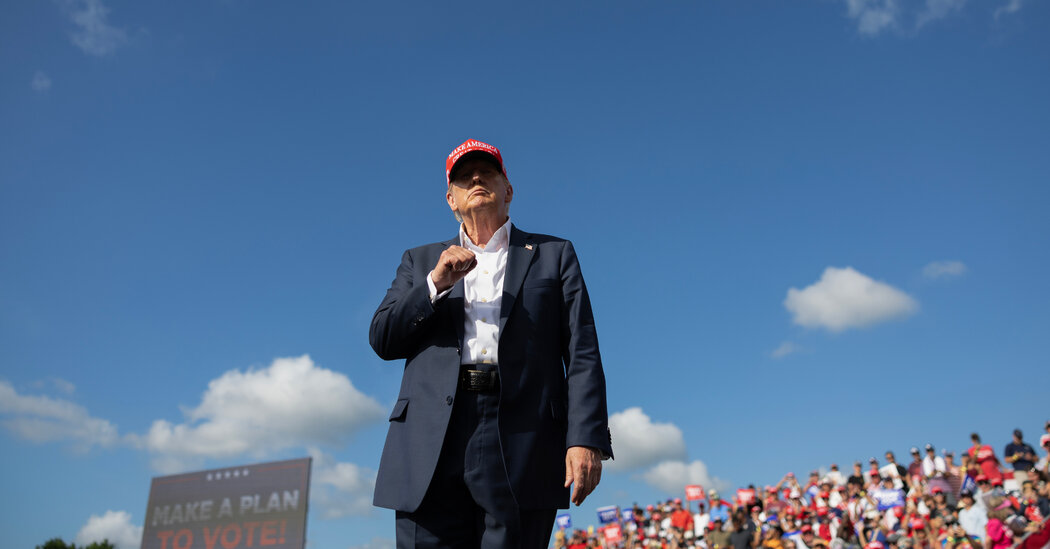January 17, 2025 | by

Seven years in the past, when Republicans handed essentially the most important overhaul of the tax code in a technology, they had been certain the legislation would supercharge funding, increase wages and shift the American economic system into the next gear.
So did it?
The reply, at the least for now, is essentially misplaced to historical past.
A pandemic and a surge in inflation convulsed the worldwide economic system not lengthy after the legislation handed in 2017, scrambling the info that analysts would have sometimes relied on to attract conclusions about whether or not the tax cuts helped the economic system develop the way in which Republicans had promised.
Consequently, policymakers in Washington at the moment are counting on solely a partial understanding of the legislation’s previous as they weigh committing roughly $5 trillion towards persevering with it.
“Principally, from 2020 the info is form of ineffective,” stated Alan Auerbach, an economics professor on the College of California, Berkeley, who counts Kevin Hassett, a high financial adviser to President-elect Donald J. Trump, amongst his former college students.
Economists have centered on simply two years earlier than the coronavirus pandemic, 2018 and 2019, to measure the legislation’s penalties for a very powerful economic system on the earth. However that’s a restricted window for making an attempt to discern whether or not the tax cuts prompted a cycle of funding and progress that may take years to play out.
“By way of taking a look at longer-run results, just about simply neglect about it,” Mr. Auerbach stated. “There’s simply no option to management for the consequences of Covid.”
Not that every part in regards to the 2017 tax legislation is a thriller. The laws slashed marginal tax charges for nearly each particular person revenue bracket, created a bigger customary deduction and expanded the kid tax credit score. For companies, the legislation lower the company price to 21 % from 35 %, quickly incentivized new capital investments, overhauled the taxation of earnings abroad and supplied a brand new deduction to house owners of many sometimes smaller corporations.
To Republicans, who handed the legislation over unified Democratic opposition within the first 12 months of Mr. Trump’s first time period, these modifications amounted to an unqualified financial success. They credit score the tax cuts with robust progress and wage will increase within the years earlier than the pandemic, warning that letting most of the 2017 cuts expire, presently scheduled to occur on the finish of the 12 months, would create an financial drag.
“We noticed the facility of those tax cuts in ’18, ’19 and going into January of ’20 earlier than they had been interrupted by Covid, and the nice success that we had,” Scott Bessent, Mr. Trump’s choose to steer the Treasury Division, stated at his Senate affirmation listening to on Thursday. “If we don’t renew and prolong, then we can be going through an financial calamity.”
Economists are extra circumspect. Attempting to pinpoint the position that any single issue performs in a sprawling economic system formed by altering rates of interest, oil costs and dozens of different variables is an inherently tough process. Solely with fastidiously constructed fashions do economists supply some findings about how a tax lower impacts the economic system.
They typically view tax cuts for people as having little impact on the economic system total, regardless of their recognition. Financial analysis means that marginally decrease tax charges don’t inspire folks to work extra, which might bolster progress, and the cash that Individuals save from decrease taxes doesn’t have an effect on the economic system in an enduring means, both. So a number of the most costly items of the 2017 legislation — the decrease particular person charges and bigger customary deduction — are almost definitely the least essential to the economic system.
“If you happen to take a look at the bang for the buck of various sorts of tax reforms, you’ll discover broad particular person tax cuts aren’t as progress enhancing as one thing focused at capital funding,” stated Erica York, the vice chairman of federal tax coverage on the Tax Basis, a assume tank that usually favors decrease taxes.
That leaves a lot of the scholarly concentrate on the company tax cuts included within the 2017 legislation. Textbook financial idea states that decrease taxes trigger corporations to speculate extra of their companies, which in flip helps make employees extra productive, lifting wages and the prospects of the whole economic system.
In a paper final 12 months, a crew of researchers from Harvard, Princeton and the College of Chicago reviewed a number of other ways of measuring the company response to the tax cuts. Regardless of a number of the scattered information, the lecturers concluded that the decrease company tax cuts had the truth is helped stimulate extra company funding.
The crew then used what Eric Zwick, an economist on the College of Chicago and one of many paper’s authors, referred to as “again of the envelope” modeling to extrapolate the impact of upper company funding to the efficiency of the whole economic system. They estimated that the legislation would assist the economic system turn out to be 1 % bigger over 10 years, progress that in flip pointed towards roughly $750 extra in wages for every American employee. Such a rise would nonetheless be far under the $4,000 per worker that Mr. Trump’s White Home had initially promised the company tax cuts would generate.
Mr. Zwick stated he felt assured in regards to the basic conclusions of his analysis, even when he acknowledged the added problem of understanding long-term financial results from solely two years of Covid-free information.
“It’s not ultimate,” he stated. “Having at the least 5 years of information would have been actually useful for pondering via dynamic results.”
The analysis from Mr. Zwick and his colleagues threw chilly water on the Republicans’ insistence that the tax cuts paid for themselves. Even with the added progress that Mr. Zwick and his co-authors discovered, they maintained that the decrease company taxes had price the U.S. authorities billions. Estimates on the time of the 2017 legislation’s passage discovered that it could add $1.5 trillion to the deficit over 10 years.
Republicans have lengthy argued that decrease tax charges will stoke a lot financial exercise that the federal government will accumulate simply as a lot income because it did earlier than it lower taxes. Extra not too long ago, they’ve cited higher-than-forecast tax income within the years for the reason that pandemic as proof of the tax cuts’ success.
Seemingly in response, the nonpartisan Congressional Finances Workplace defined in a current publication that a lot of the upper tax income was a results of larger inflation’s pushing up costs and earnings.
Different analysts have discovered that the advantages of the tax cuts have gone largely to the wealthy. One research by economists on the nonpartisan Joint Committee on Taxation and the Federal Reserve seemed on the near-term company response to the tax cuts, discovering that staff noticed larger earnings in consequence. However these will increase went totally to the individuals who had been already the highest earners at their corporations, with the underside 90 % of staff seeing no good points, the researchers discovered.
The discovering comes on high of the truth that the person revenue tax cuts, whereas affecting many Individuals, skewed towards most benefiting the wealthy, who pay the majority of the nation’s revenue taxes.
“There are two issues we all know it did: It elevated the deficit, and it redistributed sources towards the rich,” stated Invoice Gale, a co-director on the Tax Coverage Middle, a assume tank, of the 2017 tax legislation. “The issues which can be tougher to pin down are whether or not and the way a lot it raised funding and whether or not and the way a lot it affected wages.”
RELATED POSTS
View all


